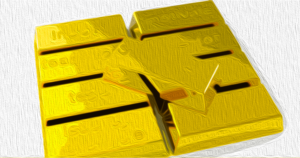
Introduction
When shopping for jewelry, it's important to understand the difference between gold-filled and gold-plated options. While both may appear similar, they have distinct differences in terms of composition, durability, price, and appearance. This guide will provide all the information you need to make an informed decision when choosing between gold-filled and gold-plated jewelry.
What is Gold-Filled Jewelry?
Gold-filled jewelry consists of layers of gold mixed with other metals, such as copper or brass. Unlike solid gold jewelry, which is made entirely of gold, gold-filled jewelry has a core metal covered with layers of gold. The process of making gold-filled jewelry involves bonding gold to the base metal using high heat and pressure. The gold purity in gold-filled jewelry is measured in karats, with 12-karat and 14-karat being the most common options. However, only a certain percentage of the alloy is pure gold, with the rest being other metals.
What is Gold-Plated Jewelry?
Gold-plated jewelry also features a layer of gold over another metal, such as sterling silver or brass. However, the amount of gold used in gold-plated jewelry is significantly less than in gold-filled jewelry. The process of creating gold-plated jewelry is simpler and involves soaking the base metal and gold in an electroplating solution and bonding them using electric current. Gold-plated jewelry is more affordable but has lower durability and is more susceptible to tarnishing.
Composition and Durability of Gold-Filled Jewelry
Gold-filled jewelry is more durable compared to gold-plated jewelry. It won't tarnish easily, making it suitable for daily wear. However, over time, the gold layer will wear off, especially with excessive use and exposure to external factors. The composition and durability of gold-filled jewelry vary based on the percentage of gold in the piece and its karat measurement. It's important to note that gold-filled jewelry contains at least 5% gold, contributing to its overall thickness and durability.
Composition and Durability of Gold-Plated Jewelry
Gold-plated jewelry has a thin layer of gold over the base metal, making it less durable compared to gold-filled jewelry. The gold plating process doesn't come with specific regulations, and gold-plated items may contain a very low percentage of gold. This thin coating can easily tarnish and wear off with minimal use. It's important to avoid exposing gold-plated jewelry to harsh chemicals and moisture to prevent damage.
Difference in Price
Gold-filled jewelry is generally more expensive than gold-plated jewelry. The process of making gold-filled jewelry is more complex, and the item must contain at least 5% gold. Gold-filled jewelry offers the appearance and durability of solid gold at a lower cost, usually ranging from $30 to $100. On the other hand, gold-plated jewelry is more affordable due to its lower gold content, with prices typically ranging from $10 to $50. Keep in mind that prices can vary depending on the retailer and the item's design.
Difference in Appearance
While gold-filled and gold-plated jewelry may appear similar at first glance, there are subtle differences in their appearance. Gold-plated jewelry tends to be more flexible due to its thin layer of gold, while gold-filled jewelry is sturdier due to its higher gold content. Gold-filled jewelry often has stamped markings indicating the karat measurement and "GF" to denote that it is gold-filled.
Care and Maintenance of Gold-Filled Jewelry
To keep gold-filled jewelry in good condition, it's important to avoid excessive moisture and harsh conditions. While gold-filled jewelry is resistant to tarnishing, it can still tarnish over time. Regular cleaning with a jewelry-safe polish and wiping can help maintain its shine and durability.
Care and Maintenance of Gold-Plated Jewelry
Gold-plated jewelry requires similar care and maintenance as gold-filled jewelry. It's important to keep the item dry and avoid exposure to harsh chemicals, lotions, perfumes, and hairsprays. After wearing the jewelry, gently wipe it with a cloth to remove dirt and oils. It's also possible to soak the item in a solution of warm water and dish soap or use a cotton swab for cleaning.
Considering Solid Gold
If you're looking for the highest quality and durability, solid gold jewelry is the best option. Solid gold jewelry doesn't contain any other metals and is resistant to tarnishing, scratches, and bumps. It is suitable for those with sensitive skin or metal allergies. However, solid gold jewelry comes at a higher price. If solid gold is beyond your budget, gold-filled jewelry offers a similar look and durability at a more affordable price.
Vermeil Gold
Vermeil gold is another alternative to consider when comparing gold-filled and gold-plated jewelry. Vermeil gold plating uses 10-karat gold and sterling silver as the base metal. This option is safer for those allergic to nickel or other alloy metals. Vermeil gold is less prone to tarnishing and is often priced similarly to gold-plated jewelry. However, it's important to avoid exposing vermeil gold to water, chemicals, lotions, and other harmful elements.
Conclusion
Understanding the differences between gold-filled and gold-plated jewelry is essential when making a purchase. Gold-filled jewelry offers higher durability and a closer resemblance to solid gold but comes at a higher price. Gold-plated jewelry is more affordable but has lower durability and is more likely to tarnish. Consider your budget, style preferences, and maintenance requirements when choosing between the two options. If solid gold is within your budget, it offers the highest quality and durability.
Note: If you're interested in investing in gold, you may also consider opening a gold IRA. For more information and guidance on investing in various gold products, reach out to the specialists at Learn About Gold.
Frequently Asked Questions
Can I buy or sell gold from my self-directed IRA
You can purchase gold with your self-directed IRA, but you must first open an account at a brokerage firm like TD Ameritrade. If you have an existing retirement account, you can transfer funds to another one.
The IRS allows individuals to contribute up to $5,500 annually ($6,500 if married and filing jointly) to a traditional IRA. Individuals can contribute up $1,000 per annum ($2,000 if they are married and jointly) directly to a Roth IRA.
If you do decide to invest in gold, you'll want to consider purchasing physical bullion rather than investing in futures contracts. Futures contract are financial instruments that depend on the gold price. You can speculate on future prices, but not own the metal. However, physical bullion is real gold or silver bars you can hold in your hands.
How much should you have of gold in your portfolio
The amount that you want to invest will dictate how much money it takes. A small investment of $5k-10k would be a great option if you are looking to start small. As you grow, it is possible to rent desks or office space. This way, you don't have to worry about paying rent all at once. Rent is only paid per month.
You also need to consider what type of business you will run. In my case, I am running a website creation company, so we charge clients around $1000-2000/month depending on what they order. This is why you should consider what you expect from each client if you're doing this kind of thing.
As freelance work requires you to be paid freelancers, your monthly salary won't be as high as mine. Therefore, you might only get paid one time every six months.
So you need to decide what kind of income you want to generate before you know how much gold you will need.
I recommend starting with $1k-$2k in gold and working my way up.
What are the fees associated with an IRA for gold?
Six dollars per month is the fee for an Individual Retirement Account (IRA). This includes account maintenance and any investment costs.
If you wish to diversify your portfolio, you may need to pay additional fees. These fees can vary depending on which type of IRA account you choose. Some companies offer checking accounts for free, while others charge monthly fees for IRA account.
Many providers also charge annual management fees. These fees are usually between 0% and 1%. The average rate is.25% per year. These rates are usually waived if you use a broker such as TD Ameritrade.
How can you withdraw from an IRA of Precious Metals?
First, you must decide if you wish to withdraw money from your IRA account. Then make sure you have enough cash to cover any fees or penalties that may come with withdrawing funds from your retirement plan.
If you are willing to pay a penalty for early withdrawal, you should consider opening a taxable brokerage account instead of an IRA. This option is also available if you are willing to pay taxes on the amount you withdraw.
Next, you'll need to figure out how much money you will take out of your IRA. This calculation depends on several factors, including the age when you withdraw the money, how long you've owned the account, and whether you intend to continue contributing to your retirement plan.
Once you have determined the percentage of your total savings that you would like to convert to cash, you can then decide which type of IRA to use. Traditional IRAs permit you to withdraw your funds tax-free once you turn 59 1/2. Roth IRAs have income taxes upfront, but you can access the earnings later on without paying additional taxes.
Once these calculations have been completed you will need to open an account with a brokerage. Most brokers offer free signup bonuses and other promotions to entice people to open accounts. However, a debit card is better than a card. This will save you unnecessary fees.
You will need a safe place to store your coins when you are ready to withdraw from your precious metal IRA. Some storage areas will accept bullion, while others require you to purchase individual coins. Either way, you'll need to weigh the pros and cons of each before choosing one.
Bullion bars are easier to store than individual coins. But, each coin must be counted separately. However, individual coins can be stored to make it easy to track their value.
Some people like to keep their coins in vaults. Others prefer to store their coins in a vault. Regardless of the method you prefer, ensure that your bullion is safe so that you can continue to enjoy its benefits for many years.
Statistics
- If you take distributions before hitting 59.5, you'll owe a 10% penalty on the amount withdrawn. (lendedu.com)
- Indeed, several financial advisers interviewed for this article suggest you invest 5 to 15 percent of your portfolio in gold, just in case. (aarp.org)
- This is a 15% margin that has shown no stable direction of growth but fluctuates seemingly at random. (smartasset.com)
- Gold is considered a collectible, and profits from a sale are taxed at a maximum rate of 28 percent. (aarp.org)
- If you accidentally make an improper transaction, the IRS will disallow it and count it as a withdrawal, so you would owe income tax on the item's value and, if you are younger than 59 ½, an additional 10% early withdrawal penalty. (forbes.com)
External Links
finance.yahoo.com
bbb.org
wsj.com
- Saddam Hussein's Invasion Helped Uncage a Bear In 1990 – WSJ
- You want to keep gold in your IRA at home? It's not legal – WSJ
forbes.com
- Gold IRA: Add Some Sparkle To Your Retirement Nest Egg
- Understanding China's Evergrande Crisis – Forbes Advisor
How To
The History of Gold as an Asset
From ancient times to the beginning of the 20th century, gold was used as a currency. It was widely accepted around the world and enjoyed its purity, divisibility and uniformity. It was also traded internationally due to its high value. Different weights and measurements existed around the world, however, because there were not international standards to measure gold. For example, one pound sterling in England equals 24 carats; one livre tournois equals 25 carats; one mark equals 28 carats; and so on.
The United States started issuing American coins in the 1860s made of 90% copper and 10% zinc. This caused a drop in foreign currency demand which resulted in an increase of their prices. In this period, large amounts of gold coin were minted by the United States, which caused the gold price to drop. The U.S. government needed to find a solution to their debt because there was too much money in circulation. They decided to sell some excess gold to Europe in order to do this.
Most European countries distrusted the U.S. Dollar and began to accept gold as payment. However, after World War I, many European countries stopped taking gold and began using paper money instead. The gold price has gone up significantly in the years since. Even though gold's price fluctuates, it is still one of the most secure investments you could make.
—————————————————————————————————————————————————————————————-
By: Learn About Gold
Title: Understanding Gold-Filled vs. Gold-Plated Jewelry
Sourced From: learnaboutgold.com/blog/gold-filled-vs-gold-plated/
Published Date: Sun, 24 Sep 2023 23:14:10 +0000



















